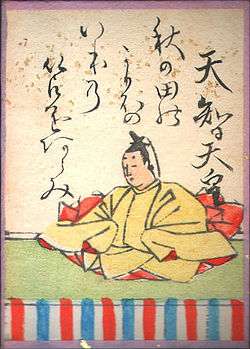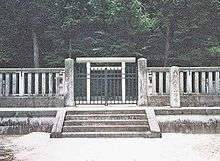Emperor Tenji
| Tenji | |
|---|---|
 (From Ogura Hyakunin Isshu) | |
| Emperor of Japan | |
| Reign | 661–672 |
| Predecessor | Saimei |
| Successor | Kōbun |
| Born | 626 |
| Died |
January 7, 672 (aged 45–46) Ōmi no Miya (Shiga) |
| Burial | Yamashina no misasagi (Kyoto) |
| Spouse |
|
| Issue |
|
| House | Yamato |
| Father | Emperor Jomei |
| Mother | Empress Kōgyoku |
Emperor Tenji (天智天皇 Tenji-tennō, 626 – January 7, 672), also known as Emperor Tenchi, was the 38th emperor of Japan,[1] according to the traditional order of succession.[2]
Tenji's reign spanned the years from 661 through 672.[3]
Traditional narrative
He was the son of Emperor Jomei, but was preceded as ruler by his mother Empress Saimei.
Prior to his accession, he was known as Prince Naka-no-Ōe (中大兄皇子 Naka-no-Ōe no Ōji).
Events of Tenji's life
As prince, Naka no Ōe played a crucial role in ending the near-total control the Soga clan had over the imperial family. In 644, seeing the Soga continue to gain power, he conspired with Nakatomi no Kamatari and Soga no Kurayamada no Ishikawa no Maro to assassinate Soga no Iruka in what has come to be known as the Isshi Incident. Although the assassination did not go exactly as planned, Iruka was killed, and his father and predecessor, Soga no Emishi, committed suicide soon after. Following the Isshi Incident, Iruka's adherents dispersed largely without a fight, and Naka no Ōe was named heir apparent. He also married the daughter of his ally Soga no Kurayamada, thus ensuring that a significant portion of the Soga clan's power was on his side.
Events of Tenji's reign
Naka no Ōe reigned as Emperor Tenji from 661 to 672.
- 661: In the 3rd year of Saimei's reign (斉明天皇三年), the empress designated her son as her heir; and modern scholars construe this as meaning that this son would have received the succession (senso) after her death or abdication. Shortly after, she died, and Emperor Tenji could be said to have acceded to the throne (sokui).[4]
- 662: Tenji is said to have compiled the first Japanese legal code known to modern historians. The Ōmi Code, consisting of 22 volumes, was promulgated in the last year of Tenji's reign.[2] This legal codification is no longer extant, but it is said to have been refined in what is known as the Asuka Kiyomihara ritsu-ryō of 689; and these are understood to have been a forerunner of the Taihō ritsu-ryō of 701.[5]
- 668: An account in Nihon Shoki becomes the first mention of petrochemical oil in Japan. In the 7th year of Tenji's reign (天智七年), flammable water (possibly petroleum) was presented as an offering to Emperor Tenji from Echigo Province (now known as a part of Niigata Prefecture).[6] This presentation coincided with the emperor's ceremonial confirmation as emperor. He had postponed formalities during the period that the mausoleum of his mother was being constructed; and when the work was finished, he could delay no longer. Up until this time, although he had been de facto monarch, he had retained the title of Crown Prince.[3]
Tenji was particularly active in improving the military institutions which had been established during the Taika reforms.[7]
Death of the emperor
Following his death in 672, there ensued a succession dispute between his fourteen children (many by different mothers). In the end, he was succeeded by his son, Prince Ōtomo, also known as Emperor Kōbun, then by Tenji's brother Prince Ōama, also known as Emperor Tenmu. Almost one hundred years after Tenji's death, the throne passed to his grandson Emperor Kōnin.
- Post-Meiji chronology
- In the 10th year of Tenji, in the 11th month (671): Emperor Tenji, in the 10th year of his reign (天智天皇十年), designated his son as his heir; and modern scholars construe this as meaning that the son would have received the succession (senso) after his father's death. Shortly thereafter, Emperor Kōbun is said to have acceded to the throne (sokui).[8] If this understanding were valid, then it would follow:
- Pre-Meiji chronology
- Prior to the 19th century, Ōtomo was understood to have been a mere interloper, a pretender, an anomaly; and therefore, if that commonly accepted understanding were to have been valid, then it would have followed:
- In the 10th year of Tenji, in the 11th month (671): Emperor Tenji, in the 10th year of his reign (天智天皇十年), died; and despite any military confrontations which ensued, the brother of the dead sovereign would have received the succession (senso); and after a time, it would have been understood that Emperor Tenmu rightfully acceded to the throne (sokui).

The actual site of Tenji's grave is known.[1] This emperor is traditionally venerated at a memorial Shinto shrine (misasagi) at Yamashina-ku, Kyoto.
The Imperial Household Agency designates this location as Tenji's mausoleum. It is formally named Yamashina no misasagi.[10]
Poetry
The Man'yōshū includes poems attributed to emperors and empresses; and according to Donald Keene, evolving Man'yōshū studies have affected the interpretation of even simple narratives like "The Three Hills." The poem was long considered to be about two male hills in a quarrel over a female hill, but scholars now consider that Kagu and Mimihashi might be female hills in love with the same male hill, Unebi.[11] This still-unresolved enigma in poetic form is said to have been composed by Emperor Tenji while he was still Crown Prince during the reign of Empress Saimei:
- Mount Kagu strove with Mount Miminashi
- For the love of Mount Unebi.
- Such is love since the age of the gods;
- As it was thus in the early days,
- So people strive for spouses even now.
- – Emperor Tenji[12]
One of his 31-letters poems was chosen by Fujiwara no Teika as the first in the very popular anthology Hyakunin Isshu.
|
|
|
After his death, his wife, Empress Yamato wrote a song of longing about her husband.[14]
Kugyo
The top court officials (公卿 Kugyō) during Emperor Tenji's reign included:
- Daijō-daijin: Ōtomo no Ōji (大友皇子), 671–672.[15]
- Naishin(内臣): Fujiwara no Kamatari (藤原鎌足) (614–669), 645–669.[15]
Prince Ōtomo (Ōtomo-shinnō) was the favorite son of Emperor Tenji; and he was also the first to be accorded the title of Daijō-daijin.[16]
Non-nengō period
The years of Tenji's reign are not linked by scholars to any era or nengō.[3] The Taika era innovation of naming time periods – nengō – languished until Mommu reasserted an imperial right by proclaiming the commencement of Taihō in 701.
- See Japanese era name – "Non-nengo periods"
- See Tenji period (661).
In this context, Brown and Ishida's translation of Gukanshō offers an explanation about the years of Empress Jitō's reign which muddies a sense of easy clarity in the pre-Taiho time-frame:
- "The eras that fell in this reign were: (1) the remaining seven years of Shuchō [(686+7=692?)]; and (2) Taika, which was four years long [695–698]. (The first year of this era was kinoto-hitsuji [695].) ... In the third year of the Taka era [697], Empress Jitō yielded the throne to the Crown Prince."[17]
Consorts and children
Empress: Yamato Hime no Ōkimi (倭姫王) (?–?), daughter of Prince Furuhito-no-Ōe (son of Emperor Jomei).
Hin: Soga no Ochi-no-iratsume (蘇我遠智娘) (d. c. 651), daughter of Soga no Kura-no-yamada no Ishikawa-no-maro
- Princess Ōta (大田皇女) (644–667), married to Emperor Tenmu
- Princess Uno-no-sarara (鸕野讃良皇女) (Empress Jitō) (645–703)
- Prince Takeru (建皇子) (651–658)
Hin: Soga no Mei-no-iratsume (蘇我姪娘), daughter of Soga no Kura-no-yamada no Ishikawa-no-maro
- Princess Minabe (御名部皇女) (b. c. 658), married to Prince Takechi
- Princess Abe (Princess Ahe) (阿閇皇女) (Empress Genmei) (661–721)
Hin: Soga no Hitachi-no-iratsume (蘇我常陸娘), daughter of Soga no Akae
- Princess Yamabe (山辺皇女) (d. 686), married to Prince Ōtsu
Hin: Abe no Tachibana-no-iratsume (阿部橘娘) (d. 681), daughter of Abe no Kurahashi-maro
- Princess Asuka (明日香皇女) (d. 700), married to Prince Osakabe
- Princess Niitabe (新田部皇女) (d. 699), married to Emperor Tenmu
Court lady: Oshinumi no Shikibuko-no-iratsume (忍海色夫古娘)
- Prince Kawashima (川島皇子) (657–691)
Court lady: Koshi-no-michi no Iratsume (越道伊羅都売)
- Princess Ōe (大江皇女) (d. 699), married to Emperor Tenmu
- Prince Shiki (施基皇子/志貴皇子) (d. 716), Father of Emperor Kōnin
- Princess Izumi (泉皇女) (d. 699), Saiō in Ise Shrine (701–706)
Court lady: Kurikuma no Kurohime-no-iratsume (栗隈黒媛娘)
- Princess Minushi (水主皇女) (d. 737)
Court lady (Uneme): Yakako-no-iratsume, a lower court lady from Iga (伊賀采女宅子娘) (Iga no Uneme)
- Prince Ōtomo (大友皇子) (Emperor Kōbun) (648–672)
Popular culture
- Portrayed by Ahn Hong-jin in the 2012–2013 KBS1 TV series The King's Dream.
Ancestry
| Ancestors of Emperor Tenji | |||||||||||||||||||||||||||||||||||||||||||||||||||||||||||||||||||||||||||||||||||||||||||||||||||||||||||||||||||||||||||||||||||||||||||||||||||||||||||||||||||||||||||||||||||||||||||||||||||||||||||||||||||||||||||||||||||||||||||||||||||||||||||||||||||||||||||||||||||||||||||||||||||||||||||||||||||||||||||||||||||||||||||||||||||||||||||||||||||||||||||||||||||||||||||||||||||||||||||||||||||||||||||||||||||||||||||||||||||||||||||||||||||||||||||||||||||||||||||||||||||||||||||||||||||||||||||||||||||||||||||||||||||||||||||||
|---|---|---|---|---|---|---|---|---|---|---|---|---|---|---|---|---|---|---|---|---|---|---|---|---|---|---|---|---|---|---|---|---|---|---|---|---|---|---|---|---|---|---|---|---|---|---|---|---|---|---|---|---|---|---|---|---|---|---|---|---|---|---|---|---|---|---|---|---|---|---|---|---|---|---|---|---|---|---|---|---|---|---|---|---|---|---|---|---|---|---|---|---|---|---|---|---|---|---|---|---|---|---|---|---|---|---|---|---|---|---|---|---|---|---|---|---|---|---|---|---|---|---|---|---|---|---|---|---|---|---|---|---|---|---|---|---|---|---|---|---|---|---|---|---|---|---|---|---|---|---|---|---|---|---|---|---|---|---|---|---|---|---|---|---|---|---|---|---|---|---|---|---|---|---|---|---|---|---|---|---|---|---|---|---|---|---|---|---|---|---|---|---|---|---|---|---|---|---|---|---|---|---|---|---|---|---|---|---|---|---|---|---|---|---|---|---|---|---|---|---|---|---|---|---|---|---|---|---|---|---|---|---|---|---|---|---|---|---|---|---|---|---|---|---|---|---|---|---|---|---|---|---|---|---|---|---|---|---|---|---|---|---|---|---|---|---|---|---|---|---|---|---|---|---|---|---|---|---|---|---|---|---|---|---|---|---|---|---|---|---|---|---|---|---|---|---|---|---|---|---|---|---|---|---|---|---|---|---|---|---|---|---|---|---|---|---|---|---|---|---|---|---|---|---|---|---|---|---|---|---|---|---|---|---|---|---|---|---|---|---|---|---|---|---|---|---|---|---|---|---|---|---|---|---|---|---|---|---|---|---|---|---|---|---|---|---|---|---|---|---|---|---|---|---|---|---|---|---|---|---|---|---|---|---|---|---|---|---|---|---|---|---|---|---|---|---|---|---|---|---|---|---|---|---|---|---|---|---|---|---|---|---|---|---|---|---|---|---|---|---|---|---|---|---|---|---|---|---|---|---|---|---|---|---|---|---|---|---|---|---|---|---|---|---|---|---|---|---|---|---|---|---|---|---|---|---|---|---|---|---|---|---|---|---|---|---|---|---|---|---|---|---|---|---|---|---|---|---|---|---|---|---|---|---|---|---|---|---|---|---|---|---|---|---|---|---|---|---|---|---|---|---|---|---|---|---|---|---|---|---|---|---|---|---|---|---|---|---|---|---|---|---|---|---|---|---|---|---|---|---|---|---|---|---|---|---|---|---|---|---|---|
| |||||||||||||||||||||||||||||||||||||||||||||||||||||||||||||||||||||||||||||||||||||||||||||||||||||||||||||||||||||||||||||||||||||||||||||||||||||||||||||||||||||||||||||||||||||||||||||||||||||||||||||||||||||||||||||||||||||||||||||||||||||||||||||||||||||||||||||||||||||||||||||||||||||||||||||||||||||||||||||||||||||||||||||||||||||||||||||||||||||||||||||||||||||||||||||||||||||||||||||||||||||||||||||||||||||||||||||||||||||||||||||||||||||||||||||||||||||||||||||||||||||||||||||||||||||||||||||||||||||||||||||||||||||||||||||
See also
Notes

- 1 2 Imperial Household Agency (Kunaichō): 天智天皇 (38)
- 1 2 Ponsonby-Fane, Richard. (1959). The Imperial House of Japan, p. 52.
- 1 2 3 Titsingh, Isaac. (1834). Annales des empereurs du Japon, p. 54., p. 53, at Google Books
- ↑ Titsingh, p. 54; Varley, H. Paul. (1980). Jinnō Shōtōki, p. 44; a distinct act of senso is unrecognized prior to Emperor Tenji; and all sovereigns except Jitō, Yōzei, Go-Toba, and Fushimi have senso and sokui in the same year until the reign of Emperor Go-Murakami.
- ↑ Varley, p. 136 n. 43.
- ↑ Aston, William George. (1896). Nihongi, p. 289 n2., p. 289, at Google Books
- ↑ Asakawa, Kan'ichi. (1903). The Early Institutional Life of Japan, p. 313.
- ↑ Brown, Delmer et al. (1979). Gukanshō, pp. 268–269.
- ↑ Titsingh, pp. 55–58.
- ↑ Ponsonby-Fane, p. 420.
- ↑ Nippon Gakujutsu Shinkokai. (1969). The Manyōshū, p. iv.
- ↑ Nippon Gakujutsu Shinkokai, p. 5.
- 1 2 3 MacCauley, Clay. (1900). "Hyakunin-Isshu: Single Songs of a Hundred Poets" in Transactions of the Asia Society of Japan, p. 3.
- ↑ Sato 2008, p. 21.
- 1 2 Brown, p. 268.
- ↑ Ponsonby-Fane, p. 53.
- ↑ Brown, p. 270.
- ↑ "Genealogy". Reichsarchiv. Retrieved 26 January 2018. (in Japanese)
References
- Asakawa, Kan'ichi. (1903). The Early Institutional Life of Japan. Tokyo: Shueisha. OCLC 4427686; see online, multi-formatted, full-text book at openlibrary.org
- Aston, William George. (1896). Nihongi: Chronicles of Japan from the Earliest Times to A.D. 697. London: Kegan Paul, Trench, Trubner. OCLC 448337491
- Brown, Delmer M. and Ichirō Ishida, eds. (1979). Gukanshō: The Future and the Past. Berkeley: University of California Press. ISBN 978-0-520-03460-0; OCLC 251325323
- MacCauley, Clay. (1900). "Hyakunin-Isshu: Single Songs of a Hundred Poets" in Transactions of the Asia Society of Japan. Tokyo: Asia Society of Japan. ...Click link for digitized, full-text copy of this book (in English)
- Nippon Gakujutsu Shinkokai (1969). The Manyoshu: The Nippon Gakujutsu Shinkokai Translation of One Thousand Poems. New York: Columbia University Press. ISBN 0-231-08620-2
- Ponsonby-Fane, Richard Arthur Brabazon. (1959). The Imperial House of Japan. Kyoto: Ponsonby Memorial Society. OCLC 194887
- Hiroaki Sato (2008). Japanese women poets: an anthology. M.E. Sharpe, Inc.
- Titsingh, Isaac. (1834). Nihon Ōdai Ichiran; ou, Annales des empereurs du Japon. Paris: Royal Asiatic Society, Oriental Translation Fund of Great Britain and Ireland. OCLC 5850691
- Varley, H. Paul. (1980). Jinnō Shōtōki: A Chronicle of Gods and Sovereigns. New York: Columbia University Press. ISBN 978-0-231-04940-5; OCLC 59145842
| Regnal titles | ||
|---|---|---|
| Preceded by Empress Saimei |
Emperor of Japan: Tenji 661–672 |
Succeeded by Emperor Kōbun |